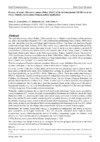Identificador persistente para citar o vincular este elemento:
https://accedacris.ulpgc.es/jspui/handle/10553/114079
| Título: | Presence of corals [Siderastrea radians (Pallas, 1766)*] of the last interglacial (130-120 ka) in the Canary Islands: marine palaeo-biogeographical implications | Autores/as: | Meco Cabrera, Joaquín Francisco Lomoschitz Mora-Figueroa, Alejandro Betancort, J.F. Soler Onis,Emilio |
Clasificación UNESCO: | 2510 Oceanografía 251001 Oceanografía biológica 2416 Paleontología |
Fecha de publicación: | 2014 | Conferencia: | IV Congress of Marine Sciences | Resumen: | The coral Siderastraea radians (Pallas, 1766) currently lives in Atlantic tropical regions of the Americas and Africa: between Brazil (Laborel, 1971), the Caribbean Sea and Bermuda islands (Verril, 1907) on the one side; and on the other, between Liberia and Cameroon; in Bioko, Sao Tomé and Annobom (Pagalu) islands and in Cape Verde (Laborel, 1974). This coral is round, spheroidal or hemispheroidal, generally characterized by irregular masses that range between 5 and 12 cm in size, but sometimes can reach 50 cm in diameter. It lives in very shallow waters and intertidal zones. In the Canary Islands, S. radians has been found within marine deposits at the following localities: Tachero, Tenerife (García Talavera et al., 1978); Las Playitas, Fuerteventura (Zibrowius & Brito, 1986; Meco, 1986); La Santa, Lanzarote (Meco et al., 2003; 2006) and San Cristóbal, Las Palmas de Gran Canaria (Meco et al., 2006). Some specimens from La Santa have diameters of as much as half a meter. With the exception of Tachero’s deposit, considered Holocene in age (Mellahian-Flandrian), the rest of localities correspond to the last interglacial period or MIS (Marine Isotope Stage) 5.5. Currently, U-series is the most reliable dating method for last-interglacial-age marine deposits and we have used it to date the fossil corals. One specimen from La Santa has an age of 130.2 + 0.8 ka and other from San Cristo´bal has an age of 120.5 + 0.8 ka (Muhs et al., 2014). These data confirm they belong to MIS 5.5. Outside the Canaries, fossil specimens of S. radians have been also found in Cape Verde Is., the Caribbean Sea (Bahamas, Florida Keys, Puerto Rico, Grand Cayman, Jamaica, Curac¸ao, Barbados) and possibly Brazil and Bermuda (Muhs et al., 2014). U-series ages at all these localities also correspond to the last interglacial. On the other hand, from the specimens found on the African coast (Mauritania, Senegal and Angola) only one coral from Mauritania was dated by radiocarbon (Chevalier and Hebrard, 1972) but its age (ca. 31 ka) is only a minimum estimate. Within the localities mentioned above, only those located on the African and Canary coasts exceeded the current boundaries of S. radians. Its palaeo-biogeographical distribution thus indicates that in the Upper Pleistocene (MIS 5.5), and along the Canary and African coasts, the Canary Current was likely warmer than today and the Guinean counter-current might be expanded; however, no such change occurred on the Atlantic American coasts, at least to the extent that allowed expansion of the range of S. radians. In other words, during the last interglacial there was an expansion of the biogeographical zone of S. radians in the central Atlantic, but this change only occurred in the African, or eastern Atlantic region. Furthermore, the Atlantic Ocean didn’t change its geographical configuration, due mainly to tectonic plate movements, in the Upper Pleistocene. Thus, the variations mentioned above might be related to astronomic causes; which changed the amount of sunshine, temperature regime, ice volumes, wind patterns, and ocean currents and, as a consequence, the marine fauna location. | URI: | https://accedacris.ulpgc.es/handle/10553/114079 | ISBN: | 84-697-0471-0 | Fuente: | Book of Abstracts submitted to the IV Congress of Marine Sciences. Las Palmas de Gran Canaria, June 11th to 13th 2014, p.p. 203-204 |
| Colección: | Actas de congresos |
Visitas
36
actualizado el 10-ene-2026
Descargas
7
actualizado el 10-ene-2026
Google ScholarTM
Verifica
Altmetric
Comparte
Exporta metadatos
Los elementos en ULPGC accedaCRIS están protegidos por derechos de autor con todos los derechos reservados, a menos que se indique lo contrario.
